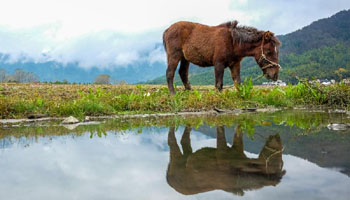SAN FRANCISCO, Nov. 21 (Xinhua) -- A new study discovered that of nearly 500 juvenile fish of the same species that had started out up to six months earlier as transparent larvae, 11.6 percent had at least one sibling in the group.
The finding, published on Monday in Proceedings of the National Academy of Sciences, a U.S. science journal, indicats that thousands of tiny offspring of the species, known as splitnose rockfish, can stick together in sibling groups from the time they are released into the open ocean until they move to shallower water.
About the "spatial cohesion" among the juvenile fish collected at depths of a few hundred meters for the study and identified through genetic analysis, Su Sponaugle, a professor of integrative biology based at Hatfield Marine Science Center of Oregon State University (OSU) noted "that's much higher than we would have expected if they were randomly dispersing."
Previously it was believed that larvae of rockfish, a group of multiple species that contribute to important commercial and recreational fisheries in the U.S. Pacific Northwest, dispersed chaotically to wherever currents carried them.
"This totally changes the way we understand dispersal," lead author Daniel Ottmann, a graduate student at the Hatfield Marine Science Center, was quoted in a news release from OSU. "We'd thought larvae were just released and then largely diffused by currents, but now we know behavior can substantially modify that."
Adult splitnose rockfish live in deep water, usually 100 to 350 meters, but juveniles often settle in nearshore habitats less than 20 meters deep after spending up to a year in the open sea. Taking into account dynamic influences, siblings "recruiting" to, namely taking up residence at, the same nearshore area suggest they remained close together as larvae rather than diffusing randomly and then reconnecting as recruits.
Splitnose rockfish range from Alaska in the United States to Baja California in Mexico and can live for more than 100 years, and a female can release thousands of able-to-swim larvae at a time.
Because larval aggregation shapes the dispersal process more than previously thought, Ottmann said, it highlights the need to better understand what happens in the pelagic ocean to affect the growth, survival and dispersal of the larvae. "Successful recruitment is critical for the population dynamics of most marine species ...Our findings have far-reaching implications for our understanding of how populations are connected by dispersing larvae."
"These tiny little fish, a few days old, out there in the humongous ocean, instead of just going wherever are able to swim and stay close together on their epic journey," said Kirsten Grorud-Colvert, an assistant professor of integrative biology at OSU. "These tiny, tiny things, sticking together in the open ocean - it's cool."










